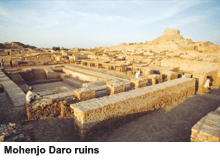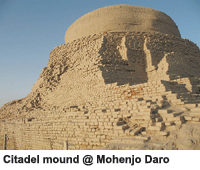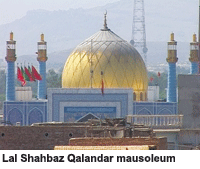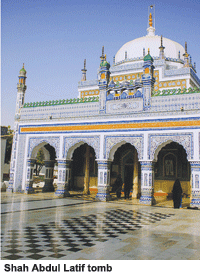Continuing his sojourn in Pakistan’s Sindh province, Yoginder Sikand and narrates his visit to Larkana, the power centre of the Bhutto family, and the ruins of Mohenjo Daro, the epicentre of the renowned Indus Valley Civilisation (2,600-1,900 b.c)
 The high-point of my month-long visit to Pakistan recently, was the week I spent traipsing around rural Sindh with Khurshid Khan Kaim Khani, a 70-year-old communist activist and old friend. We first met at a Dalit conference in Delhi two decades ago, after which we were in regular touch by mail. Khurshid had resigned from a senior position in the Pakistan Army in 1971, just before war broke out between India and Pakistan, in protest against gruesome human rights abuses by Pakistani troops in erstwhile East Pakistan. Thereafter, he got involved with various social causes, including the communist and nascent Dalit movements. One of Sindh’s leading intellectuals and social activists, Khurshid possessed a remarkable know-ledge of the history and culture of this area, an understanding that grew from years of involvement with struggles for democracy and social justice.
The high-point of my month-long visit to Pakistan recently, was the week I spent traipsing around rural Sindh with Khurshid Khan Kaim Khani, a 70-year-old communist activist and old friend. We first met at a Dalit conference in Delhi two decades ago, after which we were in regular touch by mail. Khurshid had resigned from a senior position in the Pakistan Army in 1971, just before war broke out between India and Pakistan, in protest against gruesome human rights abuses by Pakistani troops in erstwhile East Pakistan. Thereafter, he got involved with various social causes, including the communist and nascent Dalit movements. One of Sindh’s leading intellectuals and social activists, Khurshid possessed a remarkable know-ledge of the history and culture of this area, an understanding that grew from years of involvement with struggles for democracy and social justice.
Khurshid lived in Tando Allah Yar, a small town one hour by train from Hyderabad. It boasted little by way of historical interest, except for the crumbling ramparts of what had once been a fort, two public fountains built by Hindu traders before Partition which had long since fallen into disuse, and a century-old temple dedicated to the Dalit hero, Rama Pir. The town was even more filthy than Hyderabad. Most citizens lived in crowded, decrepit hovels. But, being with Khurshid more than made up for all this.
Khurshid’s father, the late Asad Ali Kaim Khani, owned a couple of acres of sandy land some 20 km from Tando Allah Yar, which he had converted into a flourishing farm. The farm, or goth in Sindhi, was Khurshid’s refuge from the squalor and deadening boredom of Tando Allah Yar. It was tiny by Sindh standards, where estates could extend to thousands of acres. His was a modest 12 acres, but it boasted rich, loamy soil that yielded two crops of rice a year, plus an annual harvest of sugarcane and mangoes. Twenty Bhil families lived in the goth.
The first evening at the goth was memorable. Balu, a big burly Bhil whom Khurshid described as ‘closer than a real brother’ announced that when two or more good people gather together, it is time to invoke God and stage a satsang. He recited in a low, measured tone, an incantation to the Divine: ‘Om shri parameshwar, om shri sat guru, om shri jagat guru’. The sadhus and sufis of Sindh perform the satsang, also known as mehfil-e-sama in Urdu and Sindhi, where bhajans and qawwalis are sung, to meld people of different castes and creeds in worship of one common and formless God. Partaking of the secular mehfil with strains from Meera bhajans, Kabir dohas and Sikh shabads in this remote backwater, held me mesmerised till the wee hours of the morning.
Unknown to me, khurshid had made elaborate arrangements for us to travel all the way to Mohenjo Daro the next morning — 600 km to the north, a journey of some ten hours — and, on the way back, to detour and visit some venerated Sufi shrines of Sindh.
We drove past Tando Allah Yar and Hyderabad, and swerved onto the main Larkana highway, crossing the Indus via the Kotri Barrage. The river waters were placid and country boats gently moved down the river with their sails billowing in the breeze, as they have for thousands of years. As we drove further north, passing into the Dadu district, the desert receded into the distance behind a row of hills. Fertile farmland spilled out on either side, stretching into the horizon. Almost all that land, Khurshid said, was owned by a single wadera (landlord), who lived in Karachi and only occasionally visited his estate. This was Sindh’s notorious feudal heartland.
 The farmland gave way to the encroaching salt-crusted desert. This had once been fertile land, but water logging caused by the construction of numerous dams on the upstream Indus, and indiscriminate use of water from canals for irrigation, had rendered it unusable. We drove past several villages and small towns. All of them showed signs of deprivation and neglect. From my perch at the back of the truck, I didn’t notice a single school building, agricultural cooperative or bank. I heard that almost half the government schools in rural Sindh don’t function at all, because of opposition from powerful landlords who don’t want landless labour to be educated and start demanding their rights.
The farmland gave way to the encroaching salt-crusted desert. This had once been fertile land, but water logging caused by the construction of numerous dams on the upstream Indus, and indiscriminate use of water from canals for irrigation, had rendered it unusable. We drove past several villages and small towns. All of them showed signs of deprivation and neglect. From my perch at the back of the truck, I didn’t notice a single school building, agricultural cooperative or bank. I heard that almost half the government schools in rural Sindh don’t function at all, because of opposition from powerful landlords who don’t want landless labour to be educated and start demanding their rights.
The sun was rapidly slipping behind the hills in the far distance by the time we reached the town of Larkana, the power centre of the Bhutto clan which has contributed two prime ministers — Zulfikar Ali and Benazir Bhutto to post-independence Pakistan. ‘Indian Oppres-sors! Quit Kashmir’, proclaimed a massive poster slung across the entry road into the town. ‘Kashmir is the Jugular Vein of Pakistan!’ informed another.
With its large shops and supermarkets, colourful neon-lights and a couple of schools set in neat campuses, Larkana is an island of prosperity in an ocean of abject deprivation. It is also the urban headquarters of many rich waderas from the surrounding countryside who live in palatial mansions, and zip around in pajeros with armed bodyguards.
From an indian tourist’s perspective, Larkana was of considerable interest. A white-washed wall, 20 ft high, encloses the grand Bhutto mansion, reputed to be the largest in the area. The heavily-guarded complex occupies an entire block. In the same neighbourhood are numerous impressive mansions of lesser waderas, although none of them even closely rivals the opulence of the Bhutto family home. And that, Khurshid caustically remarked, spoke eloquently of the much-vaunted commitment to democracy and socialism, that the Bhuttos never tired of trumpeting.
The call to fajr or early morning prayer pierced through the cardboard walls of our room. As slivers of pale sunlight filtered through the night sky, we were on the road to Mohenjo Daro, 30 km to the south-west, along lush green fields bursting with ripening wheat and sugarcane. The soil, fed for millennia from the nearby Indus, was rich and loamy, but the people and houses we drove past, all seemed desperately poor. Ironically, they are progeny of the founders of the Indus Valley Civilisation, the acme of development in the ancient world (2,600-1,900 B.C).
The towering Citadel mound that rises over the extensive ruins of Mohenjo Daro, hove into view much before we got there. The excavated ruins cover roughly 100,000 sq. metres, but this is only a tenth of the total area occupied by Mohenjo Daro at the pinnacle of its glory some six thousand years ago, when it was the nerve centre of the Indus Valley Civilisation. The unexcavated ruins of the town that stretch to the banks of the Indus river, 3 km to the north, make Mohenjo Daro the largest known Bronze Age town of the ancient world, covering a vast expanse of more than 3 million sq. metres. Excavations at the site have not proceeded much beyond the ruins unearthed in 1922 by Sir John Marshall, the British director-general of the Archaeological Survey of India. Khurshid attributes the slow progress to the reluctance of Pakistan’s rulers to highlight and promote the country’s pre-Islamic past, which could undermine its official ‘two-nation’ theory.
Mohenjo Daro was built around the Citadel, and comprised separate residential, ritual and commercial districts. A network of drains covered with baked lids and perforated with soak pits for the disposal of waste stretches along a line of brick structures (which were once houses and shops), indi-cating a remarkable drainage system which, I couldn’t help musing, seems completely alien to contemporary Pakistan. The plinth area of homes varies, indicating a rudimentary class system. At the same time, the bigger and smaller houses are clustered together, suggesting that class distinctions were perhaps not extreme and that people of different classes lived together in mixed localities.
Beyond the residential areas are a massive granary and the giant bath. Brick-paved roads, some as broad as 30 ft, crisscross the town, dividing it into blocks of roughly even size. A series of brick stairs wind round the Citadel, which was converted into a Buddhist stupa around 1,500 B.C, and had remained in use for that purpose until the town was finally abandoned, for some inexplicable reason, and given the name ‘Mound of the Dead’, which is what Mohenjo Daro means in Sindhi to this day.
The well-maintained museum nearby has salvaged some valuable and intriguing artefacts — massive stone vats, clay figurines, metal and stone weights and measures, gold and silver jewellery, stone implements and metal weapons, copper mirrors, toy carts and miniature animals, seals bearing images of animals and letters in an as-yet undeciphered pictographic script. The wealth of excavated antiquities throw light on the life of the people, adding immeasurably to our limited knowledge of the Indus Valley Civilisation.
By noon, we were back on our truck, heading southward towards Sehwan, on the way back to Khurshid’s goth. As we drove along, ripeness was all in the bountiful fields of wheat and mustard. Standing at the back of the open truck, the wind howling and the coarse sand pelting my face, it felt good to be in Sindh as the recorded voice of a woman singer extolled its beauty, the exuberance of nature, its haunting mountains, its mystic jogis and sufis.
 Sehwan owes its latter-day fame entirely to the mausoleum of a saint that crowns a hillock, at the base of which the town has spread. Little confirmed historical evidence is available about the enigmatic 13th century saint Lal Shahbaz Qalandar. But today his shrine is controlled by a rival branch of Shias — the Ithna Asharis.
Sehwan owes its latter-day fame entirely to the mausoleum of a saint that crowns a hillock, at the base of which the town has spread. Little confirmed historical evidence is available about the enigmatic 13th century saint Lal Shahbaz Qalandar. But today his shrine is controlled by a rival branch of Shias — the Ithna Asharis.
The shrine’s renovated gilded dome was visible from afar as we swept down the Lakhi hills and entered a narrow valley, shimmering in waves of heat that radiated around it like a protective halo. The road was clogged with people — literally thousands of them making their way to the dargah of Lal Shahbaz Qalandar.
The massive walls that enclose the grave of Lal Shahbaz are worthy of the gods. From top to bottom, every inch is covered with coloured, glazed tiles and bits of mosaic that intersperse the tiles are delicately crafted to form complex geometrical patterns, blooming buds, looping tendrils and verses from the Quran. Dozens of copper bells strung along the doorway, lead into the dark inner hall that houses the grave. Clouds of smoke curl out of enormous incense-holders. The grave is barely visible, except for a stone turban tied to its head. Enormous ostrich eggs, peacock feathers and embroidered cloth fans line the sides of the grave.
Invoking the blessings of the saint we left Sehwan in the late afternoon and wound our way back towards Hyderabad. Spending that night in Khurshid’s goth, we left early next morning for the town of Bhit Shah. Shah Abdul Latif, the patron poet-saint of Sindh, whose magnificent tomb is in Bhit Shah, has made the town one of Pakistan’s major Sufi centres. No visit to Sindh is complete without paying homage at his sublime darbar.
 Of all the dozens of renowned Sufis of Sindh, venerated by Sindhi Muslims and Hindus alike, Shah Abdul Latif is undoubtedly the most popular. His magnum opus, Shah jo Risalo, represents the pinnacle of Sindhi literature, containing several hundred verses set to various classical ragas.
Of all the dozens of renowned Sufis of Sindh, venerated by Sindhi Muslims and Hindus alike, Shah Abdul Latif is undoubtedly the most popular. His magnum opus, Shah jo Risalo, represents the pinnacle of Sindhi literature, containing several hundred verses set to various classical ragas.
Although he was a practicing Muslim, Shah Abdul Latif’s understanding of Islam was expansive and universal, and he did not hesitate to celebrate best practices of other faiths.
Befitting his status as the people’s poet of Sindh, Shah Abdul Latif’s darbar is vast, and its aesthetics stunning. Intricately crafted blue and white glazed tile work adorns its walls, pierced with lattice screens and sculpted verandahs. Crowds stream into the dark tomb-chamber, where his simple grave labours under a thick layer of silken sheets and rose-petals.
Our final destination as we rounded up the shrines and pilgrim spots of Sindh, was the tomb of Jhooley Lal also known as Uderolal. The eponymous township of Uderolal where the saint is buried, is an hour’s drive to the south of Bhit Shah. It has special significance for Sindh’s Hindu community, and is equally revered by Muslims.
“This is the samadhi of Jhooley Lal, the saint of the Indus river,” explained a young man in a hushed voice. “He appeared at a time when Hindus of Sindh were being forcibly converted to Islam. The son of Ratanchand and Mata Devaki, a Lohana couple, he was an avatar of the god Varuna, and saved us from forced conversion by showing Mirak Shah, the tyrannical Muslim ruler of Sindh, many miracles, thereby suitably humbling him. Don’t let the Muslims who hang around here mislead you,” the man cautioned me after I had introduced myself as a visitor from India. “They will tell you that Uderolal was a Muslim, but that is not true. They’ve concocted this story just to grab enormous amounts of money that Sindhi Hindu devotees, including many rich seths from all over the world, send to this shrine,” he added.
I turned to Khurshid for an answer, but he wasn’t very helpful. “Why fret about the dead? Think of the living instead,” he chuckled. “If you ask me, both stories are probably fictional. But, in any case, if both Hindus and Muslims worship here together in peace, that’s enough, and who needs to know more?” he asked.
And that simple approach, as I write these lines, is perhaps the only effective way to resolve the centuries-old Hindu-Muslim conflict in our part of the world, one that has transmogrified, internationalised and complicated the seemingly interminable conflict between India and Pakistan.